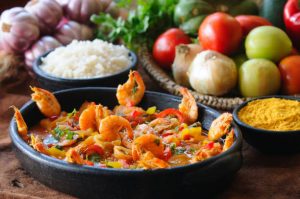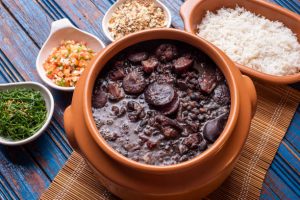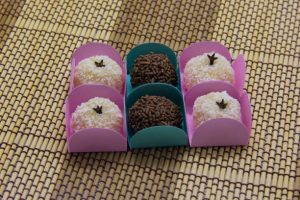Brazilian cuisine is known for its diverse and flavourful dishes, influenced by a mix of indigenous, African, and European cultures. From the tropical north to the southern regions, each area of Brazil has its own unique culinary traditions.
One of the most popular and iconic dishes in Brazilian cuisine is feijoada, a hearty stew made with black beans, pork, and beef. It is traditionally served with rice, collard greens, and orange slices.
Rice and beans is a popular dish in Brazil, often served as a staple side dish. It typically consists of white rice and black beans cooked together with onion, garlic, and various spices. It is a staple in the diet of many Brazilians and is also considered a comfort food. Some variations of this dish include the addition of meat such as sausage or beef, and some regions of Brazil may have slight variations in their preparation methods.
Rice and Beans: A Popular Staple Dish in Brazil
Churrasco is another traditional dish which features a style of barbecue that includes a variety of grilled meats, such as beef, pork, and chicken. These meats are often marinated in spices and served with chimichurri sauce.
Moqueca is another staple of Brazilian cuisine which uses fresh ingredients, such as tropical fruits, seafood, and herbs. Acai, a purple berry native to the Amazon region, is often blended into a smoothie or used as a topping for desserts. Moqueca, a fish stew originating in Bahia, is made with coconut milk, palm oil, and dendê oil, and is served with rice.

Shrimp stew in a clay bowl, accompanied with rice and manioc flour. Traditional dish of Brazilian cuisine.
Brazil is also known for its diverse street food scene, where you can find everything from traditional pastries and sandwiches to more unique dishes such as coxinha, a deep-fried dough filled with shredded chicken, and esfihas, a Middle Eastern-inspired pastry filled with meat and spices.
Brazilian cuisine also features a variety of starchy side dishes, such as mandioca (cassava) and farofa, a toasted cassava flour mixture often used as a topping for meat dishes.
Coffee is also an important part of Brazilian culture and cuisine, with Brazil being one of the largest coffee producers in the world. A traditional Brazilian coffee service, known as cafezinho, is often served after meals as a sweet, strong coffee.
Brazilian cuisine also has a rich history and cultural significance, as it was shaped by the diverse groups of people that came to Brazil throughout its history. Indigenous, African, and European influences can be found in various dishes and ingredients, making it a unique and diverse cuisine.
Brazilian cuisine is also known for its use of spices and herbs, such as cumin, coriander, and parsley, which add depth and complexity to the flavors of the dishes.
Eating out in Brazil can be quite affordable, many places offer a “rodízio” system, where you pay a fixed price and waiters bring different types of meat to your table until you are satisfied.
In addition to the dishes mentioned above, Brazilian cuisine offers a wide variety of options for vegetarians and vegans. Dishes such as feijão tropeiro, a bean stew with collard greens and cassava flour, and vatapá, a creamy stew made with coconut milk and peanuts, are both vegan-friendly options. Many traditional dishes can also be adapted to be vegetarian or vegan by substituting meat with plant-based alternatives. Brazilian cuisine also includes a wide variety of sweet treats, such as brigadeiros, small balls of chocolate and condensed milk that are often coated in chocolate sprinkles, and bolo de rolo, a roll cake filled with goiabada (guava paste) and cream.
In conclusion, Brazilian cuisine is a diverse and delicious blend of cultures and flavors, with something to offer for everyone. From traditional dishes like feijoada and churrasco to sweet treats like brigadeiros and bolo de rolo, the possibilities are endless. With its mix of indigenous, African, and European influences, it’s a unique and delicious cuisine worth exploring.









